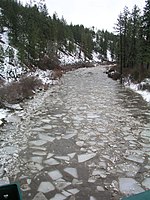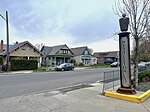Battle of Spokane Plains
1858 in Washington TerritoryConflicts in 1858History of Spokane, WashingtonNative American history of Washington (state)Wars between the United States and Native Americans ... and 1 more
Washington Territory

The Battle of Spokane Plains was a battle during the Coeur d'Alene War of 1858 in the Washington Territory (now the states of Washington and Idaho) in the United States. The Coeur d'Alene War was part of the Yakima War, which began in 1855. The battle was fought west of Fort George Wright near Spokane, Washington, between elements of the United States Army and a coalition of Native American tribes consisting of Kalispel (Pend Oreille), Palus, Schitsu'umsh (Coeur d'Alene), Spokan, and Yakama warriors.
Excerpt from the Wikipedia article Battle of Spokane Plains (License: CC BY-SA 3.0, Authors, Images).Battle of Spokane Plains
North Wright Road, Spokane
Geographical coordinates (GPS) Address Nearby Places Show on map
Geographical coordinates (GPS)
| Latitude | Longitude |
|---|---|
| N 47.677867 ° | E -117.475915 ° |
Address
Mukogawa Ft. Wright Institute
North Wright Road
99201 Spokane
Washington, United States
Open on Google Maps








